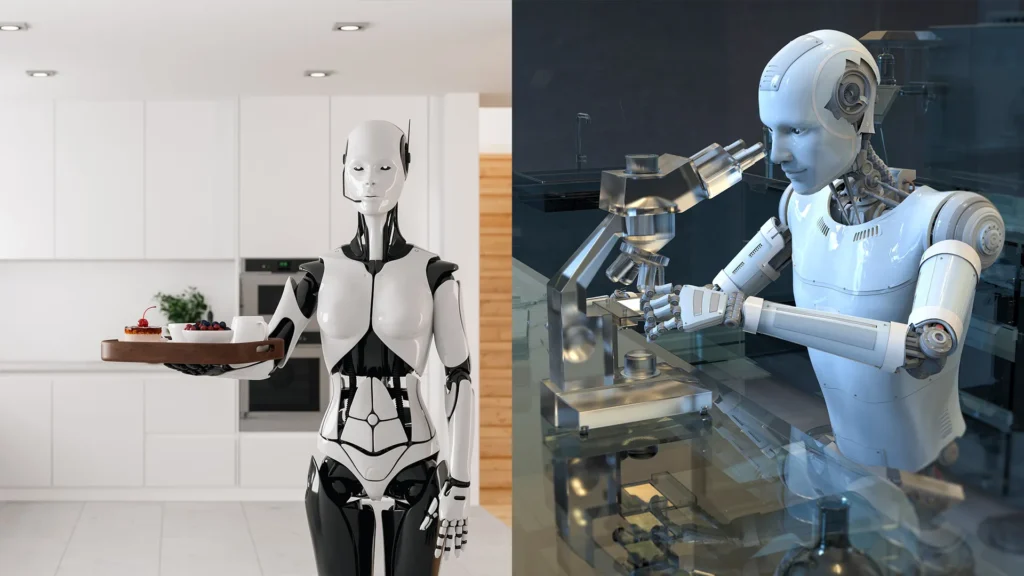
Humanoid robots have long been a staple of science fiction, but recent advancements are propelling them into real-world applications. As these human-like machines become more integrated into various sectors, we must assess our readiness for their widespread adoption. This article explores the current state of humanoid robotics, their applications, challenges, and the societal implications of their integration.
Advancements in Humanoid Robotics
Humanoid robotics has witnessed significant progress, driven by advancements in artificial intelligence (AI), machine learning, and electromechanical components. In January 2025, Tesla’s CEO Elon Musk announced plans to manufacture thousands of Optimus humanoid robots by the end of the year, aiming to increase production in subsequent years. These robots are designed to perform tasks ranging from household chores to complex industrial operations.
Similarly, companies like UBTech in China are developing humanoid robots capable of working alongside other robots, learning, and improving job performance autonomously. These developments indicate a global race to lead in humanoid robotics, with significant investments fueling rapid advancements.
Real-World Applications
Humanoid robots are being deployed across various industries, demonstrating their versatility and potential impact:
- Manufacturing and Logistics: Companies like Figure have enhanced their humanoid robots’ locomotion using AI, enabling more natural movements. These robots are being tested in factory settings, such as BMW’s facilities, to assist with tasks like assembly and material handling.
- Healthcare and Eldercare: Humanoid robots are envisioned to address labor shortages in eldercare, assisting with daily activities and companionship. Their human-like appearance and behavior can comfort patients, enhancing the quality of care.
- Public Safety and Surveillance: In Shenzhen, China, humanoid “police robots” have been deployed to patrol streets alongside human officers, participating in information collection and public service tasks.
- Hospitality and Customer Service: Robots are being introduced in retail stores, museums, and hotels to interact with customers, provide information, and perform service tasks, enhancing customer experience and operational efficiency.
Challenges and Considerations
Despite the promising applications, several challenges hinder the widespread adoption of humanoid robots:
- Technical Limitations: Achieving human-like dexterity, balance, and adaptability remains a significant hurdle. While AI has improved, robots still struggle with tasks that require fine motor skills and complex decision-making.
- Cost and Scalability: The high cost of development and production limits accessibility. Companies are working to reduce costs through innovations in actuation and materials to enable mass adoption.
- Ethical and Social Implications: Integrating humanoid robots raises questions about job displacement, privacy, and human-robot interaction norms. Ensuring that robots complement rather than replace human workers is a critical consideration.
- Regulatory and Safety Concerns: Establishing standards and regulations to ensure the safe operation of humanoid robots in public and private spaces is essential. This includes addressing potential security risks and ensuring compliance with existing laws.
The Road Ahead
The future of humanoid robotics is poised for transformative growth. Collaborations between technology companies, research institutions, and governments are accelerating advancements. For instance, Accenture and Schaeffler are working with NVIDIA and Microsoft to pave the way for industrial humanoid robots, integrating AI and robotics to enhance automation.
Furthermore, the development of generalist robotics models, such as NVIDIA’s Isaac GR00T N1, aims to provide open-source, customizable frameworks to accelerate humanoid robot development.
Conclusion
Humanoid robots are transitioning from conceptual prototypes to functional entities in various sectors. While significant progress has been made, challenges remain in achieving widespread, practical deployment. Addressing technical, ethical, and regulatory considerations will be crucial as society prepares to integrate human-like machines into daily life. The collaborative efforts of industry leaders, policymakers, and the public will determine the trajectory of humanoid robotics and their role in shaping the future.






